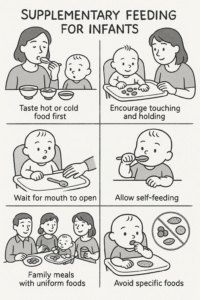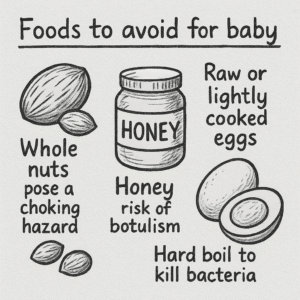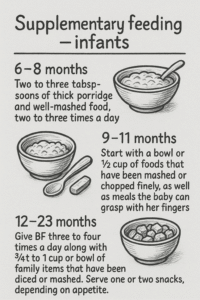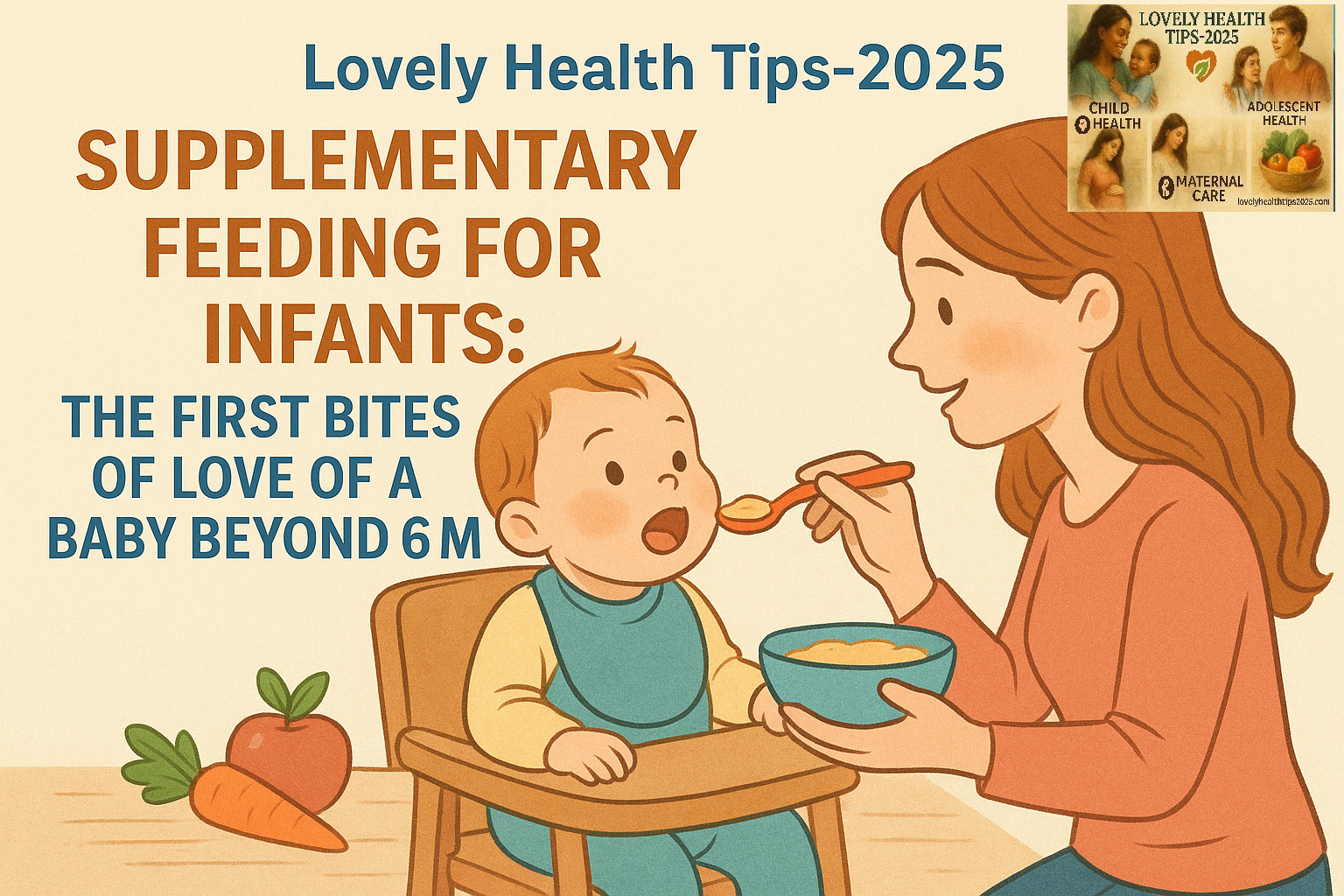Last Updated on October 21, 2025 by
Supplementary feeding for infants : During growth of bay, they require food other than breast milk, so we must introduce the complementary food this time is very much important. Starting after 6 months, a baby requires semi-solid foods alongside breastfeeding to fulfill their growth, brain development, and immunity development.
Supplementary feeding for infants
A kid should consume solid or semi-solid foods at least twice a day between the ages of 6 and 8 months, and three times a day between the ages of 9 and 24 months as Complementary Feeding.
- Breastfeed your child at every point when he feels hungry till at least the age of two.
- Foods should be the right consistency for the age of the consumer. From six months, your baby should have mashed or crushed fruits and vegetables which have been drained to become a puree. Foods should be lumpy between the ages of 7 and 9 months. Soon after 9 months age of baby, many kinds of finger foods which are meant to be taken with our fingers & thumbs may be introduced.
- Foods which we will provide to baby, must have different varieties of tastes, textures & hues.
- The Supplementary feeding for infants food should be hygienic in nature i.e it should be cooked using pure water and safe ingredients & may be stored and re-heated according to hygienic norm.
- Now, when the infant has attended six months, please start with a modest portions of food & then gradually increase the amount, also continuing to breastfeed frequently as per norm.
- Consume foods that are lower in sugar, salt and spices. We must encourage to consume the fresh homely made & cooked meals for the infants.
- When unwell, urge the child to consume soft, favorite foods and increase fluid, baby should be fed at the breast more often.
- Encourage the youngster to eat more and give meals more frequently than normal after illness.
Parents should provide supplementary nutrition to infants for reasons that aren’t limited to nutrition.
- We must try to develop the speech of infant through swallowing and chewing process. Also encouragement to the infants must be done for their progress.
- We should keep in mind that Babies being supplementarily fed need
- Select a time, when you are not in a hurry, and when your child is not most tired. Hence, your baby may get some time to find the experience of eating food with a spoon, so keep the infant calm & quiet. They may be encouraged to use their own finger for taking any food even if they make a mess. The baby demonstrates early indications that it needs to be fed and is totally alert An observant mother will quickly notice the moments when their child is hungry. It is the right time to introduce foods.
- Use a support when alive in the seated position and keep the baby away from television sets and phones or blackberries.
You shouldn’t offer your infant, food which is overly hot or cold, else taste it for yourself first.
- First & foremost, please don’t try to provide all dishes at a time, but try to give one new dish at a time.
- You should always keep an eye to your infant while they are eating for different safety reasons, and help them when they need assistance. Encourage you baby to touch and hold the food and then take. We have to wait for baby to open his/her mouth before offering food, if we’re using a spoon. Also, your infant may like holding a spoon and feed him/herself. We should not coerced our infant into eating or finishing their food. Baby-led feeding is the process of letting your child feed on his or her own.
- To make uniformity in the family & everyone, meals for the baby may be the same as those of the other family members.
- · Be aware of the specific foods that your child should continue to avoid till they are older.

Foods to avoid for baby
Chopped nuts are okay but whole nuts should not be given to young children below the age of five because, they may choke on the nuts.
Bacteria that cause newborn poisoning (botulism) may be present in honey.
Eggs should be cooked till they are hard boiled to kill any bacteria.

Supplementary feeding – infants
a. 6 – 8 months :
Two to three tablespoons of thick porridge and well-mashed food, two to three times a day, are a good way to begin supplemental feedings. Continue to breastfeed frequently (BF). (15 ml or 3 teaspoons is equal to 1 tablespoon).
b. 9 – 11 months :
Start with a bowl or ½ cup of foods that have been mashed or chopped finely, as well as meals the baby can grasp with her fingers. Give BF three to four meals a day. Serve one or two snacks, depending on appetite. 250 ml (1 cup/bowl)
c. 12 – 23 months :
- Give BF three to four times a day along with ¾th to 1 cup or bowl of family items that have been diced or mashed. Serve one or two snacks, depending on appetite.

FAQs :
Q1. Does, supplementary feeding in infants is the activity of providing extra-foods other than breast milk at the age of six months?
Ans. When infants reach six months of age medical professionals agree it is time to introduce solid food and semi-solid food together with breast milk in what is known as complementary feeding. Solid portions of food improve nutritional requirements in developing infants.
Q2. When is 6 months considered the best fitting period to introduce supplemental feeding for infants?
Ans. Around six months of age a baby begins running out of stored iron so breast milk no longer fulfills all necessary nutritional needs. Supplementary feeding for infants introduced at this time leads to both healthy body growth together with proper brain development.
Q3. Can supplementary feeding replaces breastfeeding of infants?
Ans. The introduction of supplementary feeding for infants during breastfeeding does not mean breastfeeding should stop. Supplementary foods serve to expand the nutritional choices of the baby beyond breast milk but breast milk stays the main nourishment after 6 months as babies incorporate new tastes and textures into their diet.
Q4. What are the suitable foods I should begin with?
Ans. New foods should include well-cooked lentils alongside iron-fortified cereals and mashed fruits (banana or avocado) and cooked and pureed vegetables (carrot or sweet potato) which are easy to digest. Start feeding your baby one particular food at its own time for Supplementary feeding for infants.
Q5. The initial times for introducing solid foods to my baby require how much frequency.
Ans. Initiate two small portioned meals per day together with breast milk as the main food source. At about 8 to 9 months old your child should progress to 3 to 4 scheduled meals that should be accompanied by nutritious snacks whenever needed i.e. Supplementary feeding for infants.
Q6. What is the correct portion level for meals of a 6-month-old baby?
Ans. Your baby will show the way between learning to eat and milk consumption at this stage. Increase the food amount as soon as your child demonstrates the growth of appetite and interest.
Q7. What indications show me that my baby is prepared to receive supplementary food?
Ans. As below:
- A 6 months old infant ought to maintain a sitting posture without a lot of support.
- Your baby takes interest when you are eating at meals times
- The baby is able to move about solid food to the back of his/her mouth and then, swallow it.
- The tongue-thrust reflex has disappeared in Baby.
Q8. The dietary guidelines for supplementary feeding for infants include which foods I need to eliminate.
Ans. Honey poses a risk for botulism therefore it should be avoided in addition to avoiding cow’s milk as a drink and added sugars alongside salt and choking hazards which include whole grapes and nuts and popcorn.
Q9. Do, before changing the eating behaviors of babies, they tend to be unenthusiastic concerning consuming new foods in their eating activities?
Ans. Infants usually require a number of exposures to new food, ranging between eight and ten, to indicate acceptance. Your efforts to provide food need patience along with no force or pressure.
Q10. The preparation of homemade baby food is possible.
Ans. Instead of relying on ready-made baby foods, you can make them at home so they’re free of additives and filled with a variety of flavors. When preparing homemade baby food it should be soft with proper cooking completion while also remaining swallowable.
Q11. Does iron in your baby’s food a key focus during supplementary feeding ?
Ans. In order to protect brain development and fight anemia, you should eat iron regularly. Present your infant with pureed meat items along with iron-fortified cereals and lentils and dark leafy vegetables as iron sources.
Q12. Parent should introduce textured finger foods along with soft solids when their child reaches 8 to 10 months of development.
Ans. Between 8 to 10 months parents should offer their babies a transition from liquids to mashed foods along with soft lumps and finger foods such as small pieces of steamed vegetables and soft fruits to help with chewing development.
Q13. Mom should provide food allergens to her baby at an early age for tests as allergies may develop.
Ans. Give your child small amounts of peanuts, eggs and common allergens one at a time and watch them to see if there’s a reaction. Seek pediatric advice because food allergy risks increase among families where allergies have been diagnosed.
Q14. What are the things I can do to make a pleasant mealtime experience with my infant?
Ans. Let your baby eat only when you notice they are alert and able to feed themselves. Provide self-feeding opportunities to the baby after his readiness develops.
Guideline of WHO for supplementary feeding for infants and its link as mentioned below: https://www.who.int/publications/i/item/9789240081864
Thanks and Regards
About the Author – “Mr. Bibhu Ranjan Mund”, Master in Public Health (MPH) from IIHMR University, Jaipur (Rajasthan) has experience of 18 years in Public Health activities. Through “Lovely Health Tips-2025”, we share the evidence & experienced based health & wellness guides with solutions for every day well-being. More from Author
Disclaimer
This information is suggestive only and not a replacement for medical advice. For more detail, please visit to my website as mentioned below:


1 thought on “Supplementary feeding for infants :The First Bites of Love of a Baby Beyond 6 m”